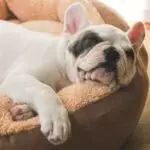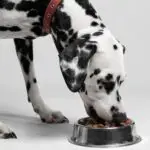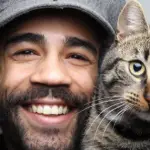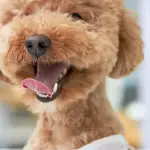Your cat’s third eyelid may be exposed or not fully retracting for many reasons including allergies, infection, irritation, and intestinal parasites. Many times, the issue is self-limiting and not serious but in some cases, your cat will need to be treated medically by a veterinarian.
Keep reading to learn exactly what causes your cat’s third eyelid to show and how to treat the issue.

What is your cat’s third eyelid?
The third eyelid also known as the nictitating membrane or nictitans is a membrane that can fully cover the surface of your cat’s eye but should always fully retract.
Normally it is not fully exposed and sits in the corner of the eye barely visible unless your cat moves it. It is used to keep the eye moist and protected.
9 possible reasons your cat’s third eyelid may be showing?
There can be many things that can cause inflammation and subsequent third eyelid protrusion.
1. Infection
If your cat has an infection or conjunctivitis, usually due to bacteria, this may cause the third eyelid to be exposed
2. Allergies
Many pet owners notice that their cat’s third eyelid is exposed around the allergy season. The exposed third eyelid may also be accompanied by sneezing, ocular discharge, or nasal discharge.
3. Injury
Issues like corneal ulcers or lacerations may cause your cat’s third eyelid to be exposed
4. Irritation
If your cat’s third eyelid is exposed it may be due to irritation. This can come from exposure to dirt, dust particles, or other irritants.
5. Eye Disease
There are some eye diseases that can cause your cat’s third eyelid to remain exposed.
6. Fever
Sometimes when cats have high body temperatures their third eyelid can be exposed as well.
7. Dehydration
Cats that are older, thin, and dehydrated can lose some tissue around their eyes which causes the third eyelid to be exposed
8. Nerve damage
Nerve damage on your cat’s neck or face can cause the third eyelid to remain exposed in one or both of the eyes. There may be other signs as well such as the inability to have muscle movement on their face or changes in pupil size.
9. Intestinal Upset
GI upset is thought to be a fairly common cause of third eyelid prolapse in cats, this is also known as Haws syndrome and usually occurs when your cat has an intestinal parasite, infection, or food intolerance.
Haws syndrome in cats
What is Haw’s syndrome?
Haws syndrome is also known as bilateral nictitans protrusion or bilateral third eyelid protrusion and is when both eyelids are showing in most cases concomitant with diarrhea or some type of gi infection.
Your cat is able to partially control their eyelid through their sympathetic nervous system. When they aren’t able to do so the third eyelid is unable to fully retract which causes both of the third eyelids to remain exposed.
What causes Haws syndrome in cats?
The exact cause of Haw’s syndrome in cats is not fully known so more studies are needed to determine the syndrome’s pathology.
However, it is usually associated with another disease or infection such as a parasitic infection.
Which parasites are seen the most with Haw’s syndrome?
Giardia: Any intestinal infection should be treated with the appropriate dewormer or antimicrobial.
Tapeworm: If your cat has fleas you should have him or her checked for tapeworms as oftentimes they can get the worm by ingesting fleas infected by tapeworm eggs
Viral and bacterial infections of the gut: viral infections like toro-like viruses have also been found in cats that exhibited signs of third eyelid prolapse
While parasites or viruses are not noted in every case of Haw’s syndrome it is more common than not that the syndrome is concomitant with another issue.
Does age matter? Any cat can develop Haw’s syndrome but it is seen more often in younger cats.
How do you treat Haw’s syndrome in cats?
The syndrome is usually self-limiting but may persist for a month or more. Usually, 4-6 weeks is the time that owners notice their cat’s third eyelid exposed.
In most cases, treatment is not necessary and the issue resolves on its own but if your cat’s third eyelid is exposed for more than two months you should see your vet again for further workup.
If your cat’s vision is obscured your vet can prescribe phenylephrine eye drops to help.
What should you do if your cat’s third eyelid is exposed
See your veterinarian
There they can do a fecal to check for endoparasites like worms or other infections like giardia. If your cat has concomitant diarrhea a fecal is definitely recommended. They can also treat any underlying conditions and if needed give you eye drops or other medication.
Clean and dust
Keep your cat away from irritants and allergens as much as possible.
If you think the reason for your cat’s eyelid exposure may be dust or debris wipe everything down, especially from high cat towers that can accumulate excessive dust. Also, try using litter that doesn’t kick up a lot of dust.
Treat allergies
If you know what your cat is allergic to do your best to keep them away from the cause. You may also need to use an air purifier.
Provide Appropriate Protections From Infection and Trauma.
Keep your cat’s nails trimmed to an appropriate length so they don’t accidentally cut themselves. Have them checked for any corneal ulcers or lacerations at your veterinarian
Give your cat adequate water
Keep your cat’s water bowl full and fresh. Cats are extremely picky when it comes to their water as they would prefer fresh flowing water. If you are using a water bowl and your cat does not seem happy about it try a water fountain.
References
https://www.seer.ufrgs.br/ActaScientiaeVeterinariae/article/view/118829

























































































































